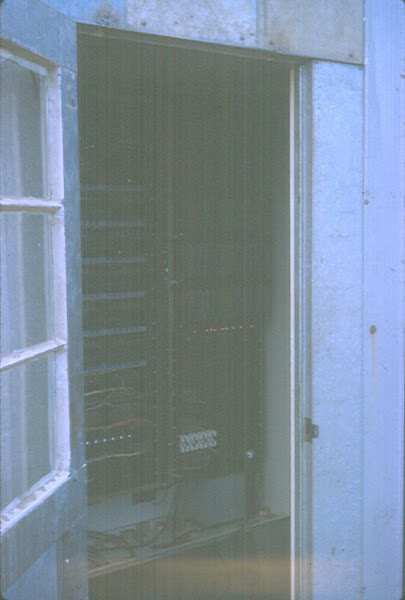One evening after we got married, Don took me and his little daughter, Valkyrie, to the factory. She was about three and a half, a cute little girl with white-blond hair and big blue eyes. He wanted to take her picture with a Polaroid camera they used for making photos of the screen of an oscilloscope. The camera lens had a black metal tube around it, about the size of a small coffee can, so they could attach it directly to the oscilloscope, blocking out all the ambient light.
Don couldn't figure out how to remove the tube from the camera, so he took her picture through it. When it developed, her face shone brightly out of an illuminated circle, surrounded by black. She looked at it and said, "Oh, I'm a sun Valkyrie." Decades later, for her birthday I gave her one of those Mexican sun images you might see on a wall. She immediately remembered that photo.
The big deal for making computers then was transistors, those remarkable little devices that replaced vacuum tubes. They looked like little metal top hats, with three wires sticking out the bottom. Don brought home a bunch of them that had been "excessed" at work. They were expensive, in the range of $30-$40 apiece. But I guess the prices had fallen, and his employers didn't think they were worth the effort to determine their type and power levels. So Don brought them home. (He still had a bunch of old vacuum tubes he had brought home from his previous employer, and he kept hauling them around from garage to garage as we moved here and there.)
He wanted to use the transistors, so he designed and built an electronic machine to test them. Then he wanted me to sit there and test them. The first part of the test was easy. I'd plug them into a socket on the machine, which indicated whether they were NPN or PNP. (That's negative-positive-negative or positive-negative-positive, referring to the three little wires.) Having figured out that much, then I was supposed to turn a dial that controlled the power going into the transistor being tested. I had to watch a needle on a numeric dial, and when it reached a certain value, I was supposed to turn off the power.
However, that was a very tricky operation, and I burned out a lot of transistors. I was happy to be relieved of that responsibility.
Don couldn't figure out how to remove the tube from the camera, so he took her picture through it. When it developed, her face shone brightly out of an illuminated circle, surrounded by black. She looked at it and said, "Oh, I'm a sun Valkyrie." Decades later, for her birthday I gave her one of those Mexican sun images you might see on a wall. She immediately remembered that photo.
The big deal for making computers then was transistors, those remarkable little devices that replaced vacuum tubes. They looked like little metal top hats, with three wires sticking out the bottom. Don brought home a bunch of them that had been "excessed" at work. They were expensive, in the range of $30-$40 apiece. But I guess the prices had fallen, and his employers didn't think they were worth the effort to determine their type and power levels. So Don brought them home. (He still had a bunch of old vacuum tubes he had brought home from his previous employer, and he kept hauling them around from garage to garage as we moved here and there.)
He wanted to use the transistors, so he designed and built an electronic machine to test them. Then he wanted me to sit there and test them. The first part of the test was easy. I'd plug them into a socket on the machine, which indicated whether they were NPN or PNP. (That's negative-positive-negative or positive-negative-positive, referring to the three little wires.) Having figured out that much, then I was supposed to turn a dial that controlled the power going into the transistor being tested. I had to watch a needle on a numeric dial, and when it reached a certain value, I was supposed to turn off the power.
However, that was a very tricky operation, and I burned out a lot of transistors. I was happy to be relieved of that responsibility.

No comments:
Post a Comment